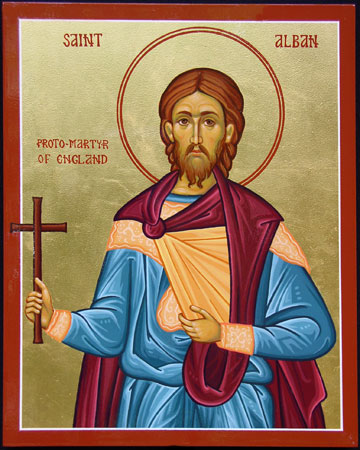SAINT ALBAN was the first martyr in
the British Isles; he was put to death at Verulamium (now called
Saint Albans after him), perhaps during the persecution under
the emperor Diocletian in the year 303 or 304, although some say
that he gave his life in the reign of the emperor Septimus
Severus, around 209.
According to the story told by St Bede the
Venerable, St Alban sheltered in his house a priest who was
fleeing from his persecutors. He was so impressed by the
goodness of his guest that he eagerly received his teaching and
received Baptism. In a few days it was known that the priest lay
concealed in St Alban’s house, and soldiers were sent to seize
him. Thereupon the St Alban put on the priest's clothes and gave
himself up in his stead to be tried.
The judge asked St Alban, ‘Of what family are
you?’
The saint answered, ‘That is a matter of no
concern to you. I would have you know that I am a Christian.’
The judge persisted, and the saint said, ‘I
was called Alban by my parents, and I worship the living and
true God, the creator of all things.’
Then the judge said, ‘If you wish to enjoy
eternal life, sacrifice to the great gods at once!’
The saint replied, ‘You sacrifice to demons,
who can bring no help or answer to the desires of the heart. The
reward of such sacrifices is the endless punishment of Hell.’
The judge was angered at the priest’s escape
and threatened the saint with death if he persisted in forsaking
the gods of Rome. He replied firmly that he was a Christian, and
would not burn incense to the pagan gods. He was condemned to be
beaten and then beheaded.
As he was led to the place of execution (the
hill on which Saint Albans abbey church now stands) it is said
that, by the martyr’s prayers, the crowd who accompanied him to
his place of execution were enabled to cross the river Coln
dry-shod. This miracle so touched the heart of the executioner
that he flung down his sword, threw himself at St Alban's feet,
avowing himself a Christian, and begged to suffer either for him
or with him. Another soldier picked up the sword, and in the
words of Bede, ‘the valiant martyr's head was stricken off, and
he received the crown of life which God has promised to those
who love Him.’
A spring of water gushed forth from the place
of the martyr’s execution, and it is said that, at the moment at
which the saint’s head fell to the ground, the eyes of his
executioner fell out of their sockets. Before this spectacle,
the governor ordered that the persecution of Christians cease,
and that due honour be paid to the glorious martyrs of Christ.
From that time, many sick people found healing through the
numerous miracles wrought at St Alban’s tomb, and his veneration
spread throughout England and also in Europe.
The shrine of St Alban had lain empty since
the destruction of the English monasteries by King Henry VIII,
but in 2002 a portion of the martyr’s relics was taken there
from the church of St Panteleimon in Cologne, Germany, where
they had been preserved for many centuries. These relics now lie
once more at the place of the saint’s martyrdom.
